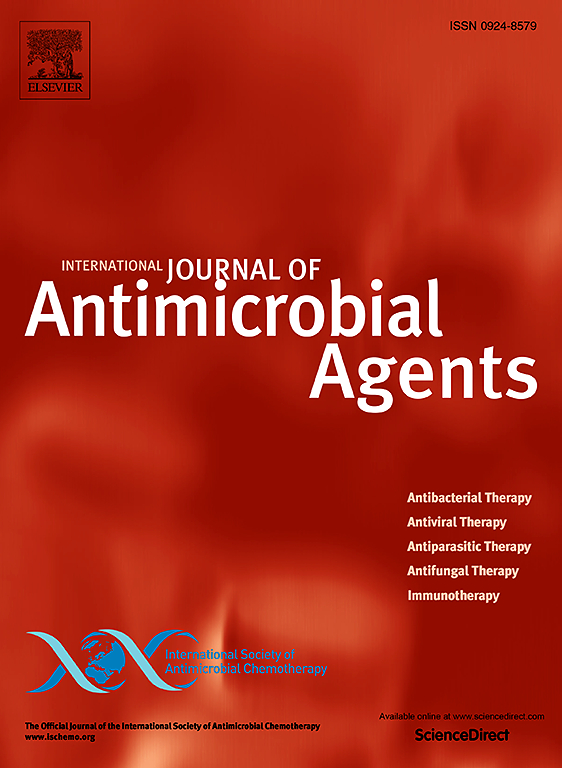耐甲氧西林金黄色葡萄球菌耐达托霉素与头孢双普罗的“跷跷板效应”。
IF 4.6
2区 医学
Q1 INFECTIOUS DISEASES
International Journal of Antimicrobial Agents
Pub Date : 2025-02-21
DOI:10.1016/j.ijantimicag.2025.107469
引用次数: 0
摘要
目的:探讨达托霉素(DAP)和头孢双prole (BPR)对耐甲氧西林金黄色葡萄球菌(MRSA)耐药菌株的“跷跷板效应”。方法:采用微量肉汤稀释法检测DAP和BPR对实验室和临床分离的DAP- r MRSA的最低抑菌浓度(mic),以评估“跷跷板效应”。利用DAP和BPR获得了7株具有代表性的DAP- r分离株的时间杀伤曲线,验证了它们的体外协同活性。通过全基因组测序以及mprF基因的缺失和互补来研究“跷跷板效应”的机制。结果:DAP-R MRSA分离株的BPR mic降低了一半。时间杀伤分析证实了DAP和BPR对典型临床和社区相关性MRSA (CA-MRSA)分离株的协同作用,表明与医院相关性MRSA相比,CA-MRSA更倾向于协同作用。在表现出“跷跷板效应”的分离株中发现了mprF突变。这些突变增加了DAP MIC,降低了BPR MIC。结论:DAP- r MRSA分离株与BPR之间存在“跷跷板效应”。这种现象与MRSA的mprF突变有关。本文章由计算机程序翻译,如有差异,请以英文原文为准。

“Seesaw effect” between daptomycin and ceftobiprole in daptomycin-resistant methicillin-resistant staphylococcus aureus isolates
Objectives
This study aimed to investigate the “seesaw effect” of daptomycin (DAP) and ceftobiprole (BPR) on DAP-resistant (DAP-R) methicillin-resistant Staphylococcus aureus (MRSA) isolates.
Methods
Broth microdilution minimum inhibitory concentrations (MICs) of DAP and BPR were tested for laboratory-derived and clinical DAP-R MRSA isolates to estimate the “seesaw effect.” Time-kill curves for seven representative DAP-R isolates were obtained using DAP and BPR to validate their synergistic activity in vitro. Whole genome sequencing as well as deletion and complementation of the mprF gene were performed to investigate the mechanisms of the “seesaw effect.”
Results
The BPR MICs decreased by half-fold in DAP-R MRSA isolates. The synergistic effect of DAP and BPR against representative clinical and community-associated MRSA (CA-MRSA) isolates was demonstrated in time-kill analyses, showing that synergistic activity was preferred in CA-MRSA compared with hospital-associated MRSA. The mprF mutations were identified in isolates exhibiting the “seesaw effect.” These mutations increased the DAP MIC while decreasing the BPR MIC.
Conclusions
The “seesaw effect” between DAP and BPR was prevalent among DAP-R MRSA isolates. This phenomenon was associated with the mprF mutations of MRSA.
求助全文
通过发布文献求助,成功后即可免费获取论文全文。
去求助
来源期刊
CiteScore
21.60
自引率
0.90%
发文量
176
审稿时长
36 days
期刊介绍:
The International Journal of Antimicrobial Agents is a peer-reviewed publication offering comprehensive and current reference information on the physical, pharmacological, in vitro, and clinical properties of individual antimicrobial agents, covering antiviral, antiparasitic, antibacterial, and antifungal agents. The journal not only communicates new trends and developments through authoritative review articles but also addresses the critical issue of antimicrobial resistance, both in hospital and community settings. Published content includes solicited reviews by leading experts and high-quality original research papers in the specified fields.

 求助内容:
求助内容: 应助结果提醒方式:
应助结果提醒方式:


